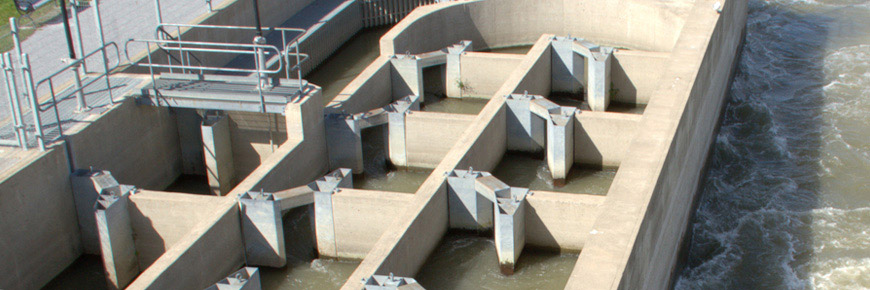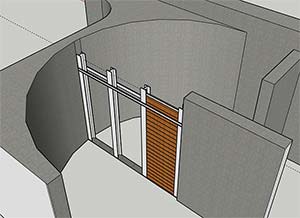
Deflectors Installation
Saint-Ours Canal National Historic Site
Installation of deflectors in the Vianney-Legendre fishway to reduce vortices and enhance effectiveness
The only one of its kind in the world, the Vianney-Legendre fishway on the Richelieu River, helps species at risk retake possession of their habitat at the Saint-Ours Canal National Historic Site. This is no ordinary fish ladder: it proves that a historic canal can be more than a heritage site, and that it can help protect biodiversity and foster the recovery of species at risk.
Over the next two years, deflectors will be installed in the fishway to enhance its effectiveness and increase species’ migration.
What is a fishway?
A fishway is like a ladder that the fish in the Richelieu River must climb one step at a time. Since 2001, this fishway has enabled endangered species to bypass the Saint-Ours Dam to spawn in their habitual breeding grounds. A special little pass was added to meet the needs of the American eel.
Why was a fishway built in the Saint-Ours Canal?
The Vianney-Legendre fishway proved necessary after a study showed that several species were at risk, including the endangered copper redhorse. The Saint-Ours Dam was preventing them from following their migratory route. The fishway is a rare and complex construction, since, unlike other fish ladders, it allows several species to migrate.
Explain the success of the fishway to date. Are you getting results? Is this a unique construction?
The Vianney-Legendre fishway is no ordinary fish ladder. It proves that the historic canal can be used for more than navigation and that it can also help protect biodiversity and foster the recovery of species at risk.
The Vianney-Legendre fishway is a rare and complex construction, since, unlike other fish ladders, it allows several species to migrate. Since its construction, hundreds of thousands of fish have been able to swim freely past the Saint-Ours Dam.
This one-of-a-kind environmental engineering project is also a tourist attraction where tourists can peer through an observation window and learn about the recovery of species at risk. Indeed, the fishway has acquired an international reputation. Although it was designed specifically for this site, other regions are interested in it as a model.
Describe the project announced today.
The fishway’s design creates vortices in the circular basins that disorient the endangered copper redhorse. According to one study, approximately 35% of fish fail to get to the other side of the fishway, mostly because of the vortex. Copper redhorse migration is thus reduced, and the endangered species is adversely affected by the fragmentation of its habitat.
Parks Canada will therefore design and install deflectors in the fishway to help the endangered species migrate. The deflectors will be made of durable, non-corrosive materials for excellent long-term sustainability.
Will the installation of the deflectors increase fishway maintenance costs?
The installation of deflectors will not affect fishway maintenance costs. There will simply be one more structural element to inspect and maintain. The deflectors won’t be costly to maintain and, because they are durable, maintenance costs will be spread out over time.
Why did you opt for deflectors rather than another technology?
Deflectors are the least expensive and most effective tool for reducing the vortex effect in the circular basins that disorients fish and makes them head back the way they came. No other option would significantly increase the effectiveness of the fishway.
What will happen after the deflectors are installed?
The deflectors are scheduled to be installed in fall 2019. In 2020 and 2021, we will be able to evaluate their effect on the vortices and the fish.
Related links
- Date modified :
